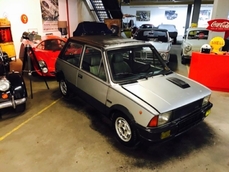Messerschmitt FMR TG 500 Umbau/Unikat ! der Hammer ! 1973
General description :
Wir verkaufen im Kundenauftrag:
Messerschmitt Tiger Umbau "" UNIKAT ""
so etwas darf in keiner Messerschmitt Sammlung fehlen !!!
etwas für den,der denkt schon alles zu haben
1970 detailverleibt und individuell umgebaut
die Lufteinlässe z.b sind Frontteile eines Jaguar E Type
die Basis war ein 3 rädriger Kabinenroller
Motor ,Achsen etc. vom Mini
Die Papiere gingen im Laufe der Jahre leider verloren
Sie erhalten jedoch einen Kaufvertrag als Eigentumsnachweiß
Angebotener Preis ist ein Festpreis !!!
Weitere Infos gerne telefonisch unter Tel 0172-7031660
Besichtigung nur nach telefonischer Vereinbarung
Weitere Oldtimer und Exoten unter "gesamtes Angebot "
oder Homepage: http://www.oldtimerboss.de
!!!! ständig ca. 50 Oldtimer und Exoten im Angebot !!!!!!!!!
1973 Messerschmitt FMR TG 500 Umbau/Unikat ! der Hammer ! is listed for sale on ClassicDigest in Pilgramstrasse 2DE-74081 Heilbronn by Handelsbüro Daniel Boss for €23750.
Car Facts
Car type : Car Make : Messerschmitt Model : FMR TG 500 Model Version : Umbau/Unikat ! der Hammer ! Engine size : 0.0 Model Year : 1973 Sub type : Convertible Location : Pilgramstrasse 2DE-74081 Heilbronn Vehicle Registration : Undefined
23750 €
Seller Information
Handelsbüro Daniel Boss
Handelsbüro Daniel Boss
+49 (0)7131 580549
Handelsbüro Daniel Boss
+49 (0)7131 580549
Other cars listed for sale by this dealer
About Messerschmitt
The transition from manufacturing fighter aircraft like the BF109 to producing three-wheeled bubble cars is a fascinating chapter in the history of the German company Messerschmitt. After World War II, with the restrictions on Germany's ability to produce traditional aircraft, companies involved in aviation had to find alternative ways to survive. Messerschmitt, led by Willy Messerschmitt, was no exception.Transition to Bubble Cars:
Post-War Restrictions:
After Germany's defeat in World War II, the country faced severe restrictions on military production. Companies involved in wartime aircraft manufacturing had to diversify their production to survive.
Messerschmitt Company Background:
Messerschmitt, known for its wartime aircraft, including the famous BF109 fighter, was initially prohibited from producing aircraft. Willy Messerschmitt, the founder, faced challenges in maintaining his company's relevance.
Microcar Concept:
In 1952, Messerschmitt collaborated with engineer Fritz Fend to produce small, economical vehicles known as microcars. These vehicles were designed to meet the demand for affordable transportation in post-war Germany.
Messerschmitt Kabinenroller (Cabin Scooter):
The first microcar produced by Messerschmitt was the Kabinenroller (Cabin Scooter), introduced in 1953. It was a three-wheeled, tandem-seated vehicle with a distinctive bubble-shaped canopy. The driver sat in the front, and the passenger sat behind.
Success of the Kabinenroller:
The Messerschmitt Kabinenroller gained popularity for its unique design and fuel efficiency. It became one of the most iconic microcars of its time.
Variants and Models:
Messerschmitt produced several variants of the Kabinenroller, including the KR175 and KR200 models. These microcars featured a narrow track, lightweight construction, and a clear bubble canopy. They were powered by small displacement engines, often motorcycle engines.
Tandem Seating and Canopy:
The tandem seating arrangement and the distinctive bubble canopy were characteristic features of Messerschmitt microcars. The bubble canopy hinged forward for entry and exit.
Market Impact:
Messerschmitt microcars were well-received in the market, especially in the context of post-war fuel shortages and economic constraints. They became a symbol of practical transportation for the masses.
End of Production:
Messerschmitt continued to produce microcars until 1964. Changes in market demands, increasing competition, and the availability of more conventional small cars contributed to the end of the Kabinenroller's production.
The transition from manufacturing fighter planes to microcars by Messerschmitt reflects the adaptability of industrial companies in post-war Europe. The Kabinenroller microcars, with their distinctive design, remain an intriguing part of automotive history.

















